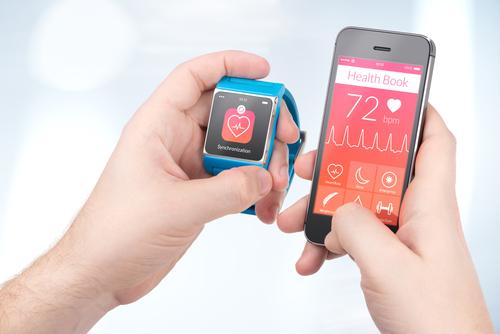It’s official: Developing wearable gadgets is all the rage.
From fitness bands to sensors that can be swallowed, wearable technology is expanding the possibilities of medicine. The evolution and expanding capabilities of wearables make them primed to transform healthcare and flip the health insurance industry on its head.
It’s official: Developing wearable gadgets is all the rage.
From fitness bands to sensors that can be swallowed, wearable technology is expanding the possibilities of medicine. The evolution and expanding capabilities of wearables make them primed to transform healthcare and flip the health insurance industry on its head.

The Evolution of Wearable Technology
Though technology has advanced by leaps in recent years, the wearable tech revolution is still only beginning. Nielsen’s Connected Life Report found that about 70 percent of consumers are aware of the wearable technology that is available, but only 15 percent of consumers report using a wearable device in their daily lives.
In the current market, wearable activity trackers are king. They come in all shapes and sizes and track and monitor everything from the number of steps you take in a day to the patterns of your sleep at night. They can even connect and transfer data to a variety of handheld devices. The success of these activity trackers is largely due to their target audience: young, physically active consumers who are more likely to have the disposable income to purchase new gadgets.
But wearable technology includes much more than pedometers and wrist-worn activity trackers. Science and medicine have been pushing the limits of wearable technology in recent years to include everything from full-sized robotic suits for paraplegics to tiny sensors that can be embedded in organs to track their functions.
As the possibilities for wearables continue to expand — taking healthcare beyond fitness tracking to more precise, personalized therapies and treatments — the industry is primed to see an explosion of new consumers.
What’s Holding Wearables Back?
With research and development backing, investor enthusiasm, and the incredible potential to change the healthcare field, what’s keeping wearable tech from being “the big thing” instead of “the next big thing”?
There are two main factors limiting the widespread adoption of wearable gadgets. The first, and perhaps most significant, is the cost. Seventy-two percent of consumers surveyed said they wished wearable devices were less expensive. As more companies jump on the wearable tech bandwagon and more devices are released to the marketplace, competition will drive the cost down, but financial assistance from insurance companies would incentivize consumers who might be held back by cost or never even consider purchasing a wearable device otherwise.
Second, the majority of devices on the market are fitness-related, and their marketing is geared toward health-conscious consumers. However, the consumers who would see the greatest impact on their health through the use of wearables are those at high risk, those with chronic illnesses, and those who lead a more sedentary life. Devices that can help these consumers are still relatively unknown to the general public, which slows their adoption. Older or less tech-savvy consumers are also more hesitant to dive into the wearable tech pool without a more direct and personalized explanation of the ways wearables will benefit them over time.
To many consumers, wearables are still a novelty. Many people don’t understand their value, especially when they see the price tag. But as more consumers are educated on the variety of devices and the specific ways these technologies will benefit their lives, the adoption rate will increase dramatically. And the best way to get consumers to see these devices in a new light is for insurance companies to begin integrating wearable technology into their business models.
Why Wearables Are Good for Insurance Companies
Insurance companies stand to benefit greatly by integrating wearable technology into their policies and coverage. They can expect:
Healthier, more engaged customers: Wearable technologies educate patients on their own bodies, empowering them to make wiser decisions about their health. Healthier customers will require fewer appointments, tests, and hospital visits. Plus, wearable devices are constant reminders for patients to set and meet health goals and recognize their progress, keeping them on track for healthier living.
Better models of risk and care: As wearable technology collects more data about individual customers, insurance companies can adjust their risk models to more accurately fit each patient. That way, the insurer and the patient are only paying for the care that particular individual needs, rather than the indeterminate needs of a group.
Stronger collaboration with healthcare providers: Wearable devices allow patients to share and transfer information to physicians from any location at any time, which can be shared with insurance providers. Physicians and insurers will have the same patient information in front of them at the click of a button, allowing all parties to work as a team to make decisions about treatment and care centered around each individual.
More specific, personalized treatments and diagnoses: Since wearable devices gather the health data of users around the clock, diagnoses and treatment plans can be fine-tuned for each patient, cutting down on the need (and cost) of labs, tests, and extended hospital stays. Patients with chronic conditions can be monitored closely from the comfort of their homes.
A lower bottom line: Overall, wearables can save insurance companies money. They could allow more patients — even those with chronic illnesses or post-operative needs — to be continually monitored outside the hospital. This will help dramatically reduce the rate of costly readmissions. The personalized and predictive data will make treatment and care more precise and less of a costly guessing game, especially after they step out of the hospital.
4 Ways Insurance Companies Can Make Wearables Work
For insurance companies to integrate wearable technology into their business models, they must find solutions that are easy to implement, add value to individual customers, and make the overall healthcare experience more pleasant. Ideas for such implementation include:
Creating tools that connect devices with insurance companies. Companies should create a platform for patients to engage with their insurer through their wearable device in an easy and purposeful way. Providers such as HumanaVitality and CarePass are already doing this by letting patients sync devices with their accounts. Insurance companies could also offer discounts or rewards to patients who connect, meet goals, and stay active and healthy.
Developing a simple consumer adoption process. Companies could offer wearable devices when consumers sign up for coverage. Have them choose a device, and ship it to their door upon checkout. The cost could even be subsidized as an additional incentive. Likewise, if a patient becomes ill or has surgery, companies can offer or suggest specific products to manage the illness or help with the recovery process.
Interpreting and using the data in meaningful ways. Insurance companies should help patients connect their devices with their doctors, provide them with insights on the product and how to get the most out of it, and offer suggestions for positive changes they can make. Helping patients feel more comfortable using their devices will ensure that their devices become a regular part of their daily life.
Serving as a tech navigator. There are so many choices out there — and even more set to hit the market in the coming years — that it can be an overwhelming experience to find the right wearable device. Health insurance companies are in the perfect position to be trusted intermediaries between manufacturers and patients. They can help patients identify the devices that are right for their specific needs, assist in curbing the cost, and provide assistance to customers as they begin integrating the devices into their daily lives.
3 Things Insurers Need to Reevaluate
The adoption of wearable technology will require some additional work from insurance providers to integrate wearables effectively. Here are three things insurance companies will need to reevaluate:
Business models: Insurance companies’ business models will need to include wearable technology. Companies can no longer sit back and estimate the risk of individuals and groups; they must become active participants in managing that risk if they want to stay relevant.
Programs: Providers will need to develop additional programs and provide an end-to-end service that can manage risk, provide insurance coverage, and use data between the systems for effective health management.
Transparency: The transparency surrounding prices and quality of medical services varies widely, even within the same network. Providers will need to be more open to build trust with their patients.
Wearable technology will be a major force in the future of medicine, yet the health insurance industry still needs to hop on board to increase adoption of these devices. Insurance providers must recognize that wearables offer a treasure trove of personalized health data that will not only revolutionize how insurance companies interact with customers, but will also help insurers, doctors, employers, and patients unite around a common goal.
(wearable tech / shutterstock)






